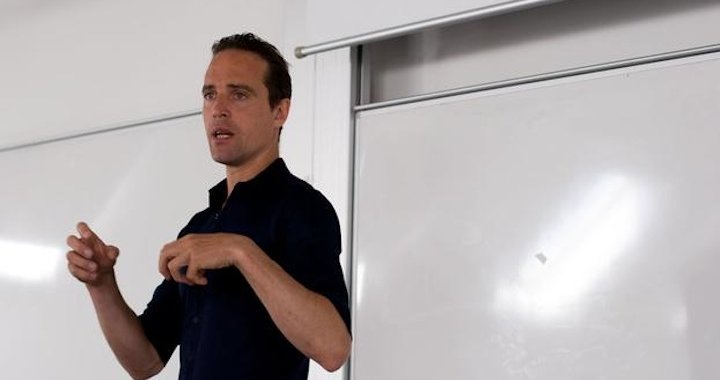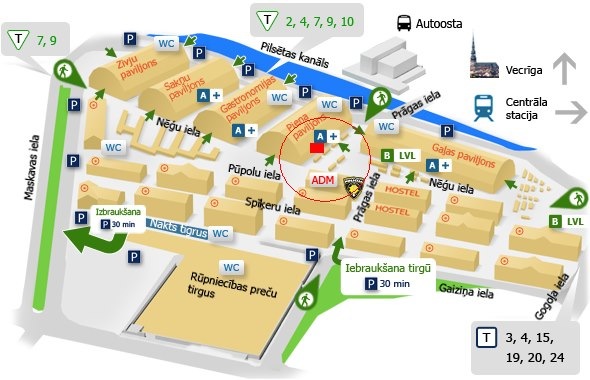
Interview with Joachim Hamou from Denmark
24/10/2012
From the October 23rd to the 25th, the curator platform Blind Carbon Copy, or BCC, is taking place at the kim? contemporary art center, as well as in the adjacent territory of Riga’s Central Market. Initiated by Juste Kostikovaite (Lithuania) and Maija Rudovska (Latvia), the platform was conceived as a meeting place in which artists and curators from the Baltic countries and Scandinavia, through the help of various small events, could raise the issue of “locality” and discourse on its meaning in terms of contemporary art. The platform’s first intervention, Curators go to the Bar, touches on performative artistic practices that are based on participation and experience, and which can function as challengers and shifters of localities. One of the participants and partners in the BCC events is the artist Joachim Hamou, from Denmark; Hamou’s objective is to create a three-day long “museum” in Riga’s Central Market, in the space once occupied by a branch office of the now-defunct Latvijas Krājbanka bank. In a conversation with the artist, Juste Kostikovaite and Maija Rudovska attempt to find out why Hamou doesn’t group himself with the curators, how important is activism in his creative practice, and why is the Riga Central Market an ideal place for a discussion on the role of cultural institutions today.

Look for a program listing and additional information at www.blindcarboncopy.org, or at the homepage for the kim? contemporary art center www.kim.lv.
The newly spotted trend of curator-artist seems to be spreading. Do you see your role as an activist, artist or/and curator from the perspective of possibility of the flexible engagement with “useful art” a la Bruguera, or, rather, you see all your practice as pure activism?
I don’t consider myself being a curator, not really an activist either. My interest and artistic practice has always been focusing on the narrative and the montage. I’m interested to work in time. It can be a performance or an event or a film. There is a strong dramaturgical work in my productions. Combining different elements such as a lecture, a performance and a film screening shouldn’t be coincidental. Each element can be seen separately but in the montage a new narrative should occur. This doesn’t mean it’s purely strategic. In contrary the ways different elements are combined are usually intuitive or associative. But there is a sense of rhythm and content that becomes clear as you work with it. An audience always try to make sense of things and this rational logic is very dynamic. The more detached the different elements are in your montage the more people have to create bridges between the different sequences and usually this lead to a stronger engagement and curiosity. By detached elements I mean for instance mixing of disciplines and gangers as well as mixing of thematic, private and public etc.
You have been actively engaged in curating various initiatives/platforms which might be related to activist movements and, as you state in your home page, contains social agenda (for example Rio Bravo, Trampoline House etc.). In Riga you will be doing three day long ‘museum in market’ project in the Riga Central Market, that will act as a catalyst to discuss the role of museum within the contemporary market and economy production. Can you elaborate on this idea and the project?
The project in Riga is for me a general investigation into the different raison d’être for cultural institutions today: Their functions, their political meanings and their conditions. As the neo-capitalist paradigm don’t seem to change anytime soon I couldn’t imagine any better aphorism then putting a museum into the market. Apart from its aphoristic meaning there are also real functions to investigate. Such as the selling and productions of object in the market and on the markets conditions. It is only interesting to do this work and investigation if it has a real potential in being a business opportunity. I made a similar project once thought it had a very different meaning. It was a “free coffee” bar outside of an art institution in Copenhagen. The project addressed the injustice for people seeking asylum in Denmark. They are not allowed to work but the money they receive is insufficient for normal living. In other words they are pushed into illegal work. In the “free coffee” bar the coffee-drinker could give a donation. The business opportunity was great! The “free coffee” bar had one of Copenhagen’s most prominent addresses and the passer by felt great giving something for a coffee that wasn’t a rip-off but at the same time the donation made a whole difference for the asylum seeker working there. The social bonus for both parts, having the opportunity of de-demonize each other, is obvious. In similar way I think about the museum in Riga’s market as having multiple purpose and opportunities. But the main function raises the questions; what do we need the cultural institutions for and what meaning do they have and under what condition do they perform? I will also quickly mention the importance of time again. This is not a timed event, it doesn’t happen between 7 and 9 PM, not even over 3 days but rather during 72 hours. It is a process that evolves over time and those investing more time will also become participants rather than observers. After I was evicted from the Rio Bravo domicile in Copenhagen we still had some events planed. We started a nomadic period and one of the early events was at the Venice Biennale 2011 in collaboration with the Danish pavilion. Instead of making a “happening” at a specific time we worked with a whole day performance using a microphone set-up miming a courtroom. Throughout the day we had different participants performing there. At the end of the day it was difficult to really tell who was the performers and who was the audience and the event ended in a party. This work in and over time is a good strategy to avoid applied slot programming.
As your practice very often involves other people, who come and spend their time while drinking coffee and sharing their time and stories, it is tempting to call your practice “participatory art”. Participatory art was a paradigm shift from marketable objects to the ephemeral events and performances, a sort of stages, where actors and audience is needed for the artwork to exist. The project that you intend to do in Riga Central Market also involves production and exchange of objects, through which both participants (volunteers) and audience will be involved. Isn’t it a kind or reversal strategy to once again employ objects, which, of course, are non objects, as they have no value or the value is lost in the moment of consumption (coffee), and recuperate them as active agents in the potentialities of communities?
The non-object, if we can call it that, is a devaluation of the art production. The museum can only sell bad copies of what is far to valuable hanging on its walls. My interest is to expand the museums repertoire and see if we can produce immanent gods such as artistic-experience-time or a museum cakes for example. I think “participatory art” is great all art should be participatory. But I don’t think there is a matrix for participation and I don’t think participation can be a goal in it self. The goal for me is a political one. I think it’s important to make the exercise to put the museum in the most extreme market condition parallel to all other gods. That might make people reflect over the value of there cultural institutions. The market in Riga is perfect for this project with the market being open all night and being a hub for homeless people who will probably be the main customers during the night. Riga’s market is also a meeting point for Latvia’s two main languages - the Russian and Latvian. The market-museum-project was also fortunate to be hosted in one of the kiosks that previously were occupied by a bank that cracked – Latvijas Krājbanka, which was very much associated to being pure Latvian bank. The symbolic value is not to be underestimated.
Many of your projects and researches are based on postcolonial discourse, that has been your interest for many years. How it relates to your identity, knowing that your family routes are mixed of different nationalities? As well how/does the personal, subjective merges into the collective interests through your projects?
Tricky question! I have always had two language identities being born in France and have had my school years in Sweden. It was only when I returned to France for some years that I realised the complexity of having grown up in an immigrant family. My family in France is Moroccan. It was as if the strong assimilation towards a French ethos just made the “otherness” more apparent, especially with my father’s generation. Naturally these observations made me more interested in colonial issues. I could talk about colonialism and power structures, self-organisation and activism for a long time but I think that’s another talk. I don’t think my projects necessarily facilitate the merging of the personal into the collective, I think this always happens in any social context. If anything I try, in my projects, to avoid or blur the hierarchic orders in the social context by addressing the simple, but easily neglected, notion of sharing.